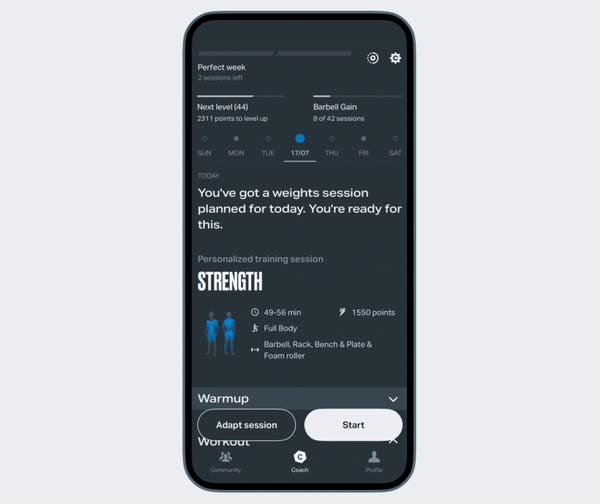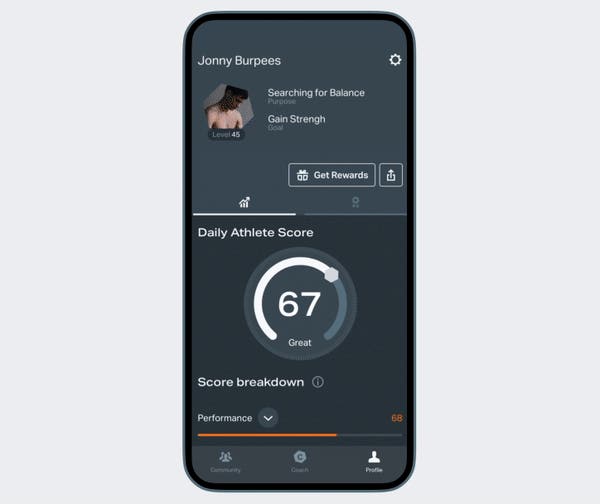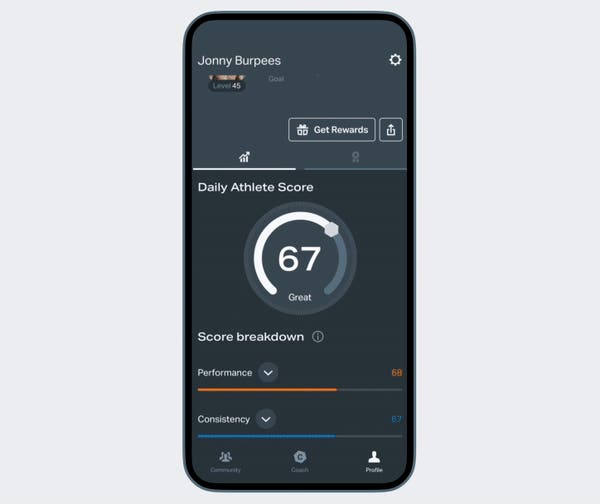New muscles and six packs you can see. Reps you can count. Speed you can measure. But fitness itself? Not so easy to quantify.
Your Daily Athlete Score (DAS) changes that by giving you a near real-time assessment of your current fitness level. It measures your best performance over the past 90 days and benchmarks them against similar Athletes, helping you to identify your strengths and areas for improvement.
While your score is benchmarked to other Athletes, it’s not meant to be a competition. Instead, the DAS is designed to motivate you by showing you your strengths and areas for improvement. By giving you a picture of your fitness over a selected period of time based on the exercises you actually perform, you can track progress and adjust your training plans or goals as needed.

How is DAS calculated?
Your overall DAS score is a weighted composite of your Performance and Consistency scores. Check it daily and track it over time as it updates after every workout.
Consistency score
A measure of how often you stick to and complete your planned Coach training sessions and/or Base activities over the past 90 days. Base activities include any workout logged in the Freeletics app or tracked in an external app synced with Freeletics, totaling at least 17 minutes.

Performance score
The average of your Skill, Stamina, Speed, and Strength scores for exercises, Coach sessions, and on-demand workouts over the past 90 days.
- Skill: Calculated based on your response to the feedback question "How was your technique?” and is not benchmarked against other Free Athletes.
- Stamina: Based on the best max number of repetitions you did for common bodyweight exercises you performed.
- Speed: Calculated by how fast you complete God and running workouts with fixed distances compared to similar Free Athletes.
- Strength: An average of your best 1-rep-max weight scores for weighted exercises or max reps for common bodyweight exercises across four body groups.

*You must have an active Coach subscription to see a Daily Athlete Score in the app.
How should I interpret my score?
Your fitness is more than just a number and there are many elements beyond age, gender, or even injury and sickness that make us different. Your DAS score should only be used as motivation to be better than yesterday.
You might “score” big while achieving short-term goals, but you could also easily have periods where your score is lower – especially between Training Journeys or when you’re just getting started. The purpose is to give you a dose of reality that will both inform you and motivate you to train consistently.
Training regularly with the Coach will naturally increase your workout difficulty and, ultimately, your score over time. If you’re at the beginning of your fitness journey, it’s important to prioritize proper form before scaling up with reps, speed, difficulty, or weights to ensure you get the most from your training and avoid injury.
Keep in mind that the score has certain limitations since DAS only includes the main exercise for each muscle category to provide a baseline, not every exercise available in the app.
We hope that seeing your fitness progress over time will encourage you to maintain a consistent, long-term level of training activity that pushes you to be your best. Because fitness doesn’t end when you step off the mat or finish one Training Journey. It’s not just part of your life – it is your life. Now and in 20, 30, or 40+ years.
Our tips for using and understanding DAS
- The overall goal of DAS: Gradual improvement is the name of the game! Train regularly, and your Coach workouts and score will level up!
- For beginners & intermediates: Stick with your Coach for steady growth and nail that technique!
- For advanced warriors: Ready for the next level? Listen to your body and dive into extra challenges to pump up your score!
Wherever you're at, there's a path to success! Let's crush those goals together!
FAQs
What does DAS measure?
The DAS analyzes over 100 different data points from your training over the past three months to give you a near real-time daily snapshot of your fitness progress across multiple measurements, including Consistency, Speed, Strength, Stamina, and Skill. Depending on your particular training, it may consider how good your exercise technique is, the number of repetitions you can do for different exercises, how fast you run or complete God workouts, how much weight you lift, and how often you work out.
What is meant by “similar athletes”?
DAS uses the demographic parameters of age, weight, and gender that you shared in your profile to benchmark your performance against other Free Athletes.
Where can I see my Daily Athlete Score?
You’ll find your DAS by clicking on the Profile tab at the bottom of the Freeletics app.
What do the different colors and shapes in the calendar mean?
- Orange circle: You have a Coach day planned today
- Empty gray circle: You don’t have a Coach session scheduled today
- Orange squares: Completed Coach session
- Empty gray square: Planned Coach days
- Gray squares: Planned Coach session that was missed
- Gray circle: No scheduled Coach session
- Blue square: Completed Base activity
What are the different score ranges, and what do they mean?
Scores fall into different ranges with labels that are only meant to motivate you to keep going. Explore what’s behind your scores in the score details screens and see which exercises or workouts you excel at, and where you can improve.
How does DAS do the math?
The overall DAS is calculated as a weighted average of Consistency and Performance scores over the past 90 days. It compares your performance to other Athletes in your age, weight, and gender demographic. Performance is assessed through an average of four sub-scores: Skill, Stamina, Speed, and Strength.
Performance scores account for both Coach and on-demand trainings completed over the last 90 days. Please remember, that not all exercises available in the app count towards your DAS—only the primary exercise for each muscle category is considered to establish a baseline.
In the Stamina, Speed, and Strength scores, only your top scores from the past 90 days are used to provide the most accurate measure of your training. You won’t be penalized for dips in performance from day to day. A more detailed description of the calculation can be found below.
Consistency: calculated based on how many of the past 90 days you’ve completed your Coach workouts or 17-minute Base activities.
Performance: an average of your Skill, Stamina, Speed, and Strength scores.
Skill: considers perceived technique and calculated based on the answer given to the feedback prompt “How was your technique?”. Unlike other scores, this calculation is based on your feedback only and there is no benchmarking involved.
Your Skill score considers all the exercises where the feedback prompt is available. Users in Dumbbell and Kettlebell Training Journeys who perform only weighted exercises might not get a Skill score as the feedback prompt is not available for certain exercises in those Training Journeys. It does not impact the overall score.
Stamina: calculated based on the maximum number of specific bodyweight exercise repetitions performed within one round or set where you performed more than 10 repetitions.
Why 10 repetitions as a threshold? According to several studies, this threshold is optimal for assessing strength and stamina. Not only that, this number also promotes endurance and stimulates muscle growth, so every set in your training counts toward your goals.
Speed: calculated based on the time you take to complete God and running workouts with fixed distances. Your score is benchmarked against other users with similar age and gender.
Strength: calculated based on the amount of weight you used and the number of repetitions, considering maximum repetitions performed within one round for a set of bodyweight exercises and the estimated 1 rep max for a set of weighted exercises. It considers only sets where you performed 10 or fewer repetitions for the most accurate 1-rep-max estimation.
The Strength score is broken into four body groups: upper-body push, upper-body pull, core, and lower body. It considers both bodyweight and weighted exercises for each group.
Your body group score is your highest score achieved from that group while your overall Strength score is the average of all group scores. Within each body group, you can see contributing exercises and stats like your highest rep or 1-rep-max and respective scores benchmarked against similar athletes.
Why doesn’t DAS count or measure the performance of all the exercises I do?
For Strength and Stamina, DAS doesn’t include every exercise available in the app – just the main one for each muscle category to get a baseline of where you are and where you can improve. We’ve carefully selected common bodyweight and weighted exercises that represent each muscle group as well as overall fitness to make the score as universally applicable and comparable as possible.
How is my score affected if I don’t perform all the exercises that DAS measures or if my Training Journey doesn’t include exercises for some or all the categories?
DAS is only calculated as an average using the best performances of the exercises you actually did in the past 90 days. Not doing certain exercises will not negatively impact your score. However, you may not display a score for certain metrics. The DAS only begins to display an overall score after 2 days of training.
What is the highest score possible?
The highest overall DAS score you can achieve is 99.
Should you aim for a high score?
While the DAS is calculated as a comparative measure to other people in your general demographic, it’s important to note that we did not design the DAS for competition. Instead, you should see it as a basis for measuring your training progress and your overall fitness that should help motivate you to be better than yesterday.
Why don’t I see a score yet?
If you don’t see a DAS yet, then we may not yet have enough data to establish trends to create a calculation. Keep training and doing exercises and workouts that the DAS takes into consideration (see “How does DAS do the math?”) and check back.
How do I avoid getting penalized when I need to skip a Coach session?
Easy. Make sure you log a Base activity instead.
How can I improve my score?
There are many ways to improve your overall score. As the DAS is made up of two key levers (Consistency and Performance), the first way to improve your score is by improving your consistency by always completing your Base. You can also raise your score by improving your scores in the different performance metrics (Skill, Stamina, Speed, and Strength).
Our advice is to try and pick one focus area to push towards 99. For example, if your goal is to gain strength, you’ll want your Strength score to be as high as possible. And while you should aim for the other scores to be high as well, when you focus on one area, it’s completely normal for your other scores to be lower.
DAS aims to motivate you by providing factual insights about your fitness and benchmarking your potential with other similar Athletes to give you an accurate picture of where you stand. If your score is relatively low and makes you feel demotivated, use it as a reminder of your untapped potential and let it be a driver for positive change and progress instead.
If you’re ready for the next level and up for a challenge, you can always explore more God workouts and fixed-distance runs, create custom workouts, or work on Single Exercises that are included in the measurements to pump up your score!
How should you understand and use your DAS?
By checking your DAS and the score breakdown in your profile, you can understand where you’re performing well vs. many other Free athletes and which areas could use improvement. Remember: The purpose of the DAS is not to aim for a score of 100 on each metric every day.
Your goal should be to improve (ideally gradually) and have an optimal score for each metric. It's possible that focusing on one area may marginally impact another. For example, focusing on maximizing speed could potentially lower your strength score, and vice versa.
And there are so many other factors that could affect your score like sickness, injury, your period, or your mental health. This is totally normal, so try not to see a dip in your score as a step backward. Instead, look at it as an opportunity to understand how elements affect your body and fitness daily.
For example, a respiratory infection is known to affect your Strength, Speed, and Stamina, but not your Skill. Remember, a performance score of 99 is great, but not the ultimate goal. The only metric that you should aim to keep at 99 at all times is consistency – because consistency is key!
Ready to see what you can do with the help of your very own AI-powered personal training plan? Start your journey towards consistent progress and see your score with the Coach.